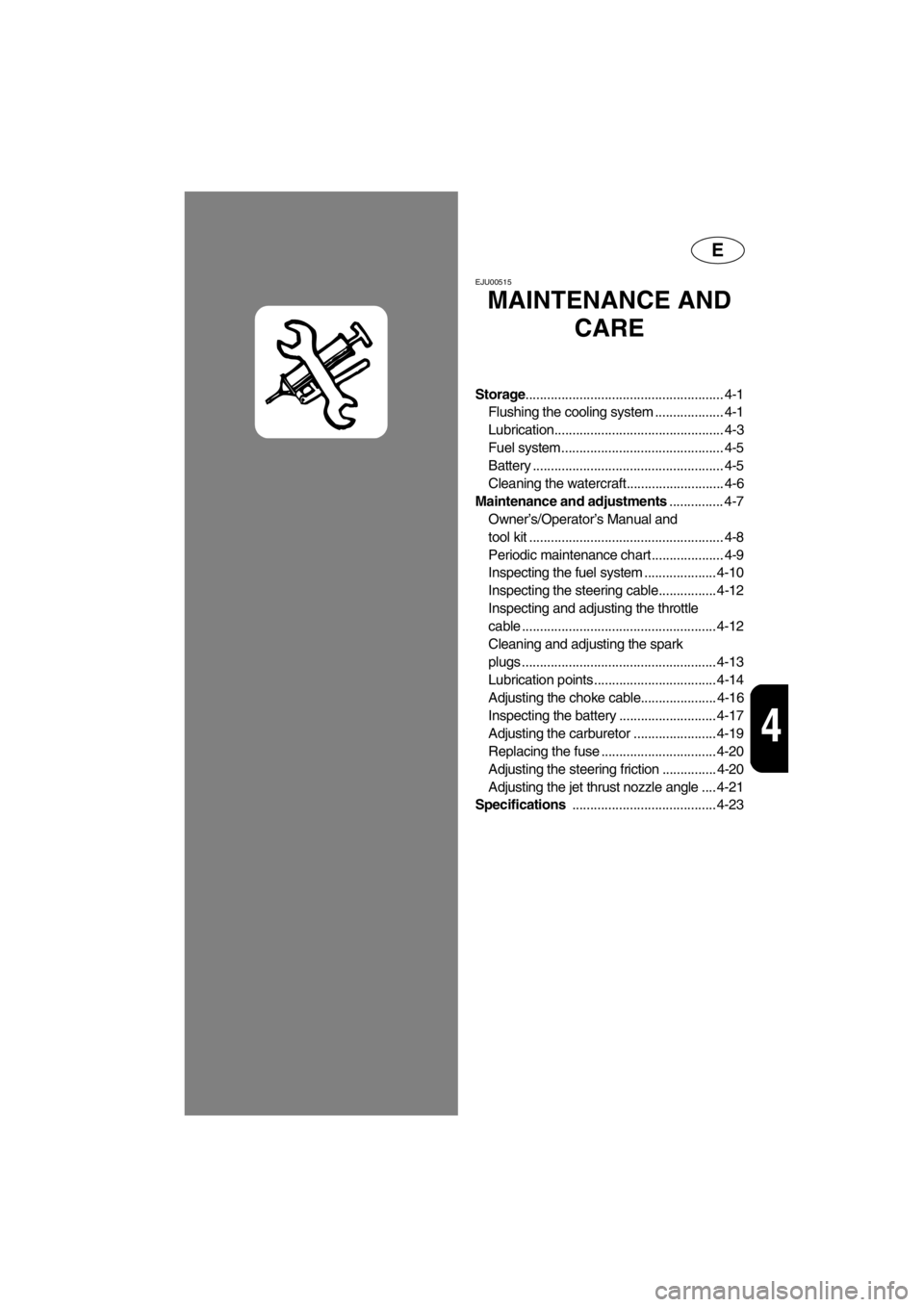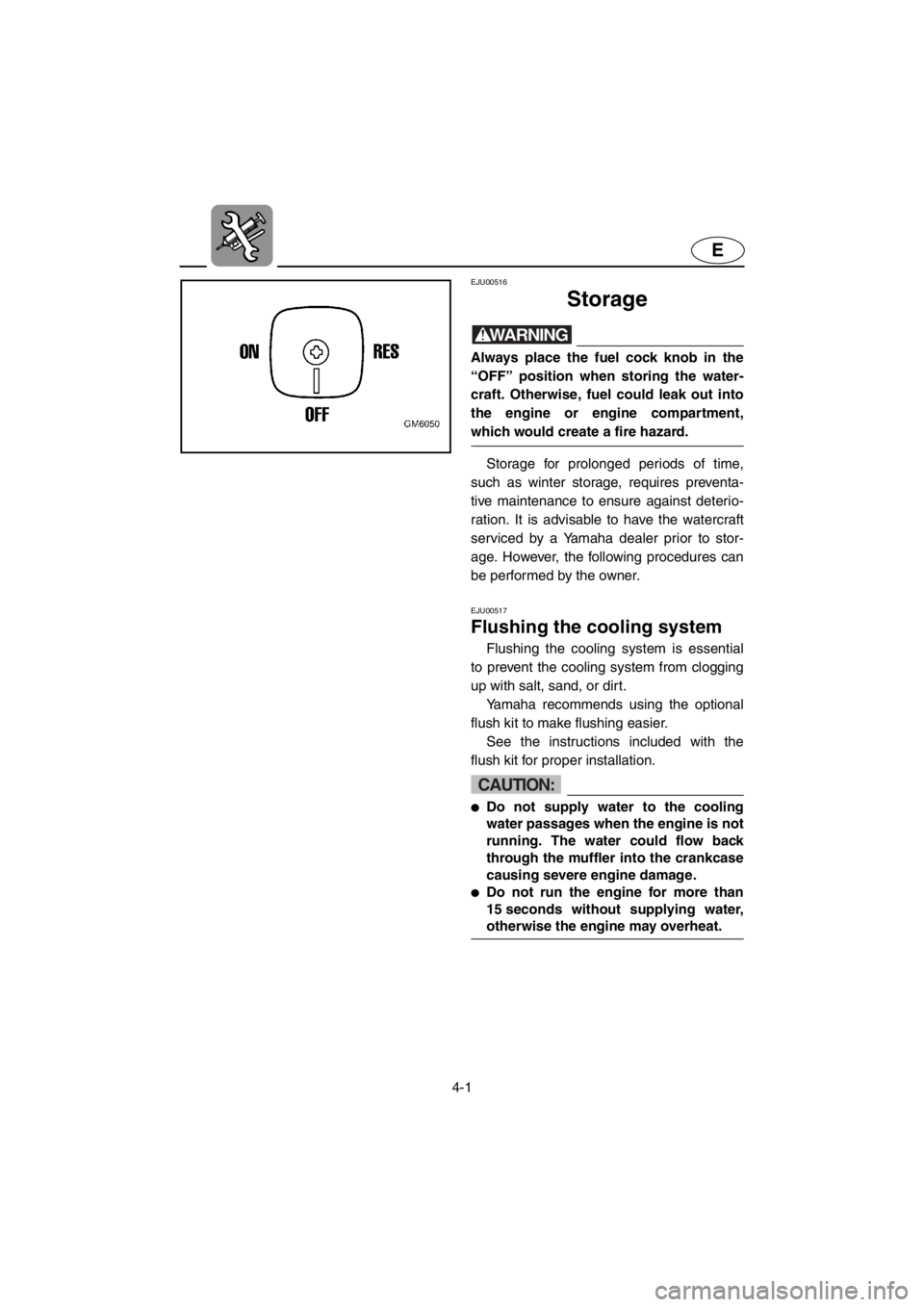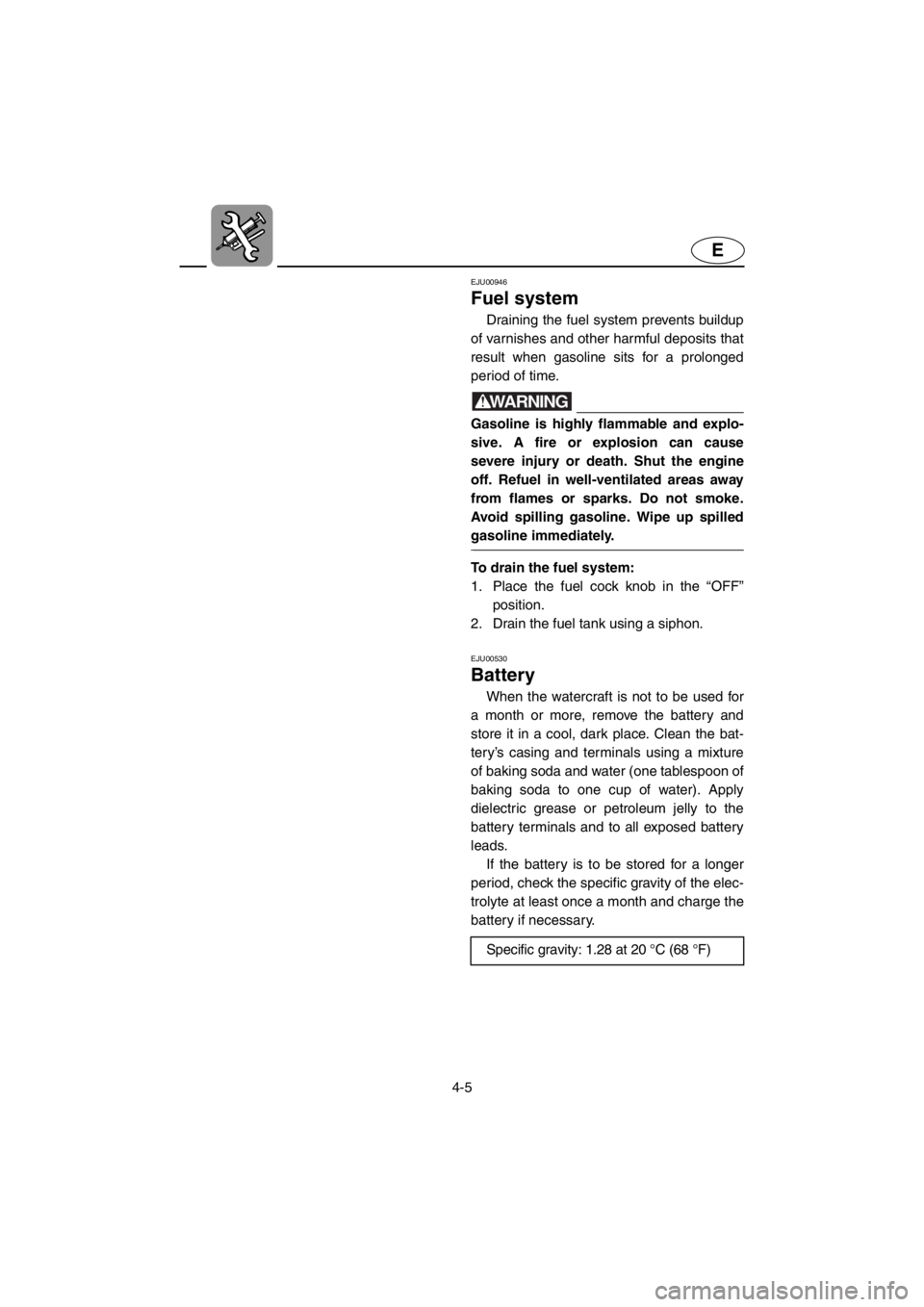Page 49 of 107
3-14
E
3. Gradually open the throttle lever to 3/4 or
less.
4. Continue operation at 3/4 throttle or less
until the first tankful of fuel has been
used.
5. Fill the tank once more with a fuel-to-oil
ratio of 25:1, and proceed with normal
operation.
CAUTION:@Failure to follow the engine break-in pro-
cedure properly can result in severe
damage to the engine.
@
E_GM6-3.fm Page 14 Tuesday, July 11, 2000 10:52 AM
Page 50 of 107

3-15
E
EJU00927
Starting the engine
WARNING@Never start the engine or let it run for any
length of time in an enclosed area.
Exhaust fumes contain carbon monox-
ide, a colorless, odorless gas that may
cause loss of consciousness and death
within a short time. Always operate the
watercraft in an open area.
@
1. Launch the watercraft in water free from
weeds and debris and at least 60 cm
(2 ft) deep.
WARNING@Never operate in water that is less than
60 cm (2 ft) deep, otherwise you increase
your chance of hitting a submerged
object, which could result in injury.
@
CAUTION:@Never operate in water that is less than
60 cm (2 ft) deep, otherwise pebbles or
sand could be sucked into the jet intake,
causing impeller damage or engine over-
heating.
@
2. Turn the fuel cock knob to the “ON” posi-
tion.
NOTE:@Before starting the watercraft after it has
been sitting, remove the fuel tank filler cap
to release any built-up pressure in the tank
due to fuel expansion.
@
E_GM6-3.fm Page 15 Tuesday, July 11, 2000 10:52 AM
Page 68 of 107
3-33
E
EJU00952
Transporting
WARNING@Always place the fuel cock knob in the
“OFF” position when transporting the
watercraft, otherwise fuel could leak out
into the engine or engine compartment,
which would create a fire hazard.
@
Transport this watercraft using the special
trailer that incorporates a hole into which the
pin 1 can be inserted and locked after
passing it through the rope hole 2.
After securing the bow with the pin, secure
the stern with ropes or tie downs 2 over the
gunwale. Use a rubber shock cord 1 to hold
the steering pole.
CAUTION:@●Do not route ropes or tie downs over
the steering pole, as they may damage
it. Also, wrap the ropes or tie downs
with towels or rags where they touch
the body of the watercraft to avoid
scratching or damage.
●Do not transport the watercraft with
steering pole up, or the steering pole
may be damaged during transporta-
tion.
@
E_GM6-3.fm Page 33 Tuesday, July 11, 2000 10:52 AM
Page 69 of 107

E
4
EJU00515
MAINTENANCE AND
CARE
Storage....................................................... 4-1
Flushing the cooling system ................... 4-1
Lubrication............................................... 4-3
Fuel system............................................. 4-5
Battery ..................................................... 4-5
Cleaning the watercraft........................... 4-6
Maintenance and adjustments............... 4-7
Owner’s/Operator’s Manual and
tool kit ...................................................... 4-8
Periodic maintenance chart .................... 4-9
Inspecting the fuel system .................... 4-10
Inspecting the steering cable................ 4-12
Inspecting and adjusting the throttle
cable ...................................................... 4-12
Cleaning and adjusting the spark
plugs ...................................................... 4-13
Lubrication points .................................. 4-14
Adjusting the choke cable..................... 4-16
Inspecting the battery ........................... 4-17
Adjusting the carburetor ....................... 4-19
Replacing the fuse ................................ 4-20
Adjusting the steering friction ............... 4-20
Adjusting the jet thrust nozzle angle .... 4-21
Specifications ........................................ 4-23
E_GM6-4TOC.fm Page 1 Tuesday, July 11, 2000 11:27 AM
Page 70 of 107

4-1
E
EJU00516
Storage
WARNING@Always place the fuel cock knob in the
“OFF” position when storing the water-
craft. Otherwise, fuel could leak out into
the engine or engine compartment,
which would create a fire hazard.
@
Storage for prolonged periods of time,
such as winter storage, requires preventa-
tive maintenance to ensure against deterio-
ration. It is advisable to have the watercraft
serviced by a Yamaha dealer prior to stor-
age. However, the following procedures can
be performed by the owner.
EJU00517
Flushing the cooling system
Flushing the cooling system is essential
to prevent the cooling system from clogging
up with salt, sand, or dirt.
Yamaha recommends using the optional
flush kit to make flushing easier.
See the instructions included with the
flush kit for proper installation.
CAUTION:@●Do not supply water to the cooling
water passages when the engine is not
running. The water could flow back
through the muffler into the crankcase
causing severe engine damage.
●Do not run the engine for more than
15 seconds without supplying water,
otherwise the engine may overheat.
@
E_GM6-4.fm Page 1 Tuesday, July 11, 2000 11:28 AM
Page 74 of 107

4-5
E
EJU00946
Fuel system
Draining the fuel system prevents buildup
of varnishes and other harmful deposits that
result when gasoline sits for a prolonged
period of time.
WARNING@Gasoline is highly flammable and explo-
sive. A fire or explosion can cause
severe injury or death. Shut the engine
off. Refuel in well-ventilated areas away
from flames or sparks. Do not smoke.
Avoid spilling gasoline. Wipe up spilled
gasoline immediately.
@
To drain the fuel system:
1. Place the fuel cock knob in the “OFF”
position.
2. Drain the fuel tank using a siphon.
EJU00530
Battery
When the watercraft is not to be used for
a month or more, remove the battery and
store it in a cool, dark place. Clean the bat-
tery’s casing and terminals using a mixture
of baking soda and water (one tablespoon of
baking soda to one cup of water). Apply
dielectric grease or petroleum jelly to the
battery terminals and to all exposed battery
leads.
If the battery is to be stored for a longer
period, check the specific gravity of the elec-
trolyte at least once a month and charge the
battery if necessary.
Specific gravity: 1.28 at 20 °C (68 °F)
E_GM6-4.fm Page 5 Tuesday, July 11, 2000 11:28 AM
Page 78 of 107

4-9
E
EJU00536
Periodic maintenance chart
The following chart gives general guidelines for periodic maintenance. However, depend-
ing on your operating conditions maintenance may need to be performed more frequently.
(
●) This mark indicates maintenance that you may do yourself.
(
❍) This mark indicates work to be done by a Yamaha dealer.
*1: Grease capacity: 20.0–22.0 cm3 (0.68–0.74 oz)
*2: Grease capacity: 3.0–5.0 cm3 (0.10–0.17 oz) MAINTENANCE INTERVAL INITIALTHEREAF-
TER EVERYPA G E
10
hours50
hours100
hours 100
hours 200
hours
ITEM
3
months6
months6
months12
months
Spark plug Inspect, clean, adjust ●●●●
4-13
Lubrication points Lubricate●●
4-14
Intermediate housing Lubricate❍
*1●
*2●
*2 4-16
Fuel system Inspect❍❍
4-10
Fuel filter Check, replace❍❍
4-11
Fuel tank Clean❍
4-11
Carburetor setting Inspect, adjust❍❍❍
4-19
Trolling speed Adjust●●
4-19
Carburetor throttle shaft Inspect❍❍
—
Cooling water passages Flush●
(after
ever y
use) 4-1
Bilge strainer Clean●●●
—
Impeller Inspect●●●
—
Steering cable Inspect●●
4-12
Steering pivot Inspect❍❍❍
—
Steering friction Inspect●●●
4-20
Throttle cable Inspect, adjust●●
4-12
Choke cable Inspect, adjust ●●
4-16
Battery Inspect●
(Inspect
fluid level
before
ever y
use)4-17
Rubber coupling Inspect❍
—
Nuts and bolts Tighten❍❍❍
—
E_GM6-4.fm Page 9 Tuesday, July 11, 2000 11:28 AM
Page 79 of 107
4-10
E
EJU00537
Inspecting the fuel system
WARNING@Gasoline and its vapors are highly flam-
mable and explosive.
@
Check the fuel system for leakage,
cracks, or malfunctions. If any problem is
found, do the necessary repair or replace-
ment as required. If repair is necessary, con-
sult a Yamaha dealer.
Check:
●Carburetors for leakage.
●Fuel pump for malfunction or leakage.
●Fuel tank for water or dirt.
●Fuel tank for damage, cracks or leakage.
●Fuel hose joint for leakage.
●Fuel hose for cracks or other damage.
●Fuel filter for leakage.
●Fuel cock for leakage.
●Air vent check valve for leakage.
WARNING@Failure to check for and repair any fuel
leakage may result in fire or explosion.
@
E_GM6-4.fm Page 10 Tuesday, July 11, 2000 11:28 AM